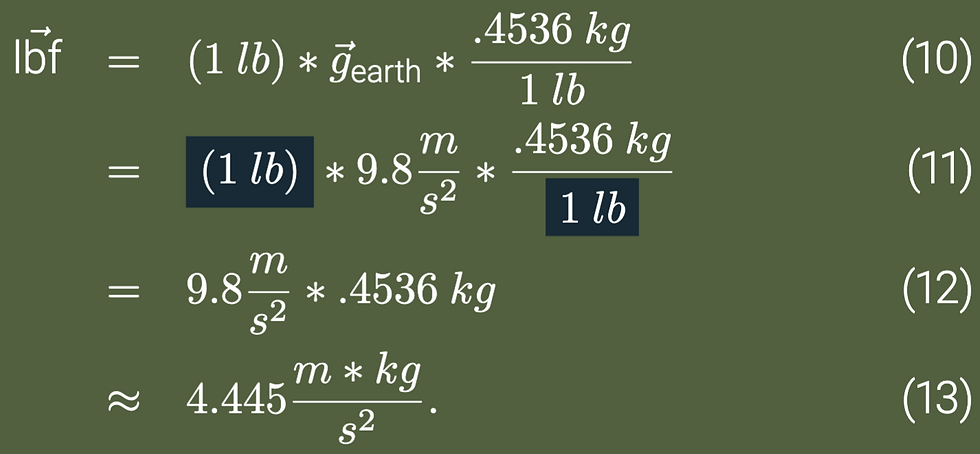Unit Analysis: The Loss of NASA's Mars Climate Orbiter
- Leenie Wilcox

- Sep 13, 2024
- 6 min read
My mother stayed in school for an extra semester and took physics because she wanted to be with her boyfriend. It is possibly the most expensive dating strategy since king Henry the VIII christened a new church just so he could get divorced, but to each their own.
My mother recounts one story of her physics teacher who would inspire the fear of God in his students by shouting, "UNITS!'' at minuscule infractions. There is an unholy sense of injustice in losing points over incorrect or missing units; as though this afterthought of physics is where snippety professors release their pent up rage. Okay, most teachers aren't as enraged as that spleeny British man who yelled "units'' at my teenage mother, and they do have a point when it comes to the importance of unit analysis. But let's be real; if you don't know the value of what you're carrying, even a backpack full of gold would feel like a fruitless burden. So let's analyze the value of the gold we carry.
In 1998, NASA launched the Mars Climate Orbiter, which they designed to collect data about the weather on Mars and relay information to Earth [2, 1]. An artist’s rendition of this is given in Figure 1. The cost of the mission was 327.6 million dollars (which is more than 570 million dollars in today’s money) [4].
![Figure 1: An artist’s depiction of the Mars Climate Orbiter taken from [2].](https://static.wixstatic.com/media/b00437_978d57bc973f4d36b3aedbff6130e201~mv2.jpg/v1/fill/w_980,h_891,al_c,q_85,usm_0.66_1.00_0.01,enc_avif,quality_auto/b00437_978d57bc973f4d36b3aedbff6130e201~mv2.jpg)
To provide some perspective on the difficulty of a space launch, when we send rockets into space, we see gravitational curvature effects much more clearly. Where here on Earth, I might hold up a ball, drop it, and we all agree that it falls in a straight line to the floor, things look a little different when we get to space. Things don’t really move in straight lines as we typically think about them. Let’s say that I’m in space and I see a little asteroid fall towards Earth on a trajectory that is close to the planet. If I drew a 'straight' line (like on a chalk board) based on a snapshot of how I see the asteroid moving, I would expect to see the asteroid pass by the planet. But the asteroid seems to change course. Rather than a straight line, I would
see it fall into orbit around Earth, and start moving along what looks like a curved line as seen in Fig 2.

Getting the Mars Climate Orbiter to Mars required some highly technical and extremely precise math. We had to first leave the ground and get into Earth's orbit. Then we had to leave Earth's orbit and get to Mars. Then we needed to slow down and fine tune how the Orbiter circled the little red planet.
When the Mars Climate Orbiter was first captured in Martian orbit, the orbital path was far too big. In order to bring the Mars Climate Orbiter into its ideal, tight orbit around the planet, the spacecraft needed to slow down. NASA planned to do this by dragging the spacecraft through the atmosphere for a short period of time over many orbits [4]. This is called areobreaking. As you might expect, the Mars Climate Orbiter has to be very close to the planet to be able to briefly dip into the atmosphere.
Allow me to list out the dangers of coming very close to a planet whilst hurtling through space at about three miles per second:
You hit the atmosphere and it feels more like a wrecking ball than a puff of air. Ultimately you are okay, but you will have some strong words for Houston.
You hit the atmosphere, bounce off, and fly away into the inky blackness of space. You are less okay, but you will suddenly have a lot of free time to contemplate this fact.
You hit the atmosphere and slow down so much that you aren’t able to leave the atmosphere. At this point, you will either have the opportunity to go out in a blaze of glory akin to a fireworks display, or you will greet the ground with a sudden intimacy. You are not having a good day at all really, but you won’t have much time to think about that.
NASA hired some software developers from Lockheed Martin to calculate the change in momentum produced by the thrusters [5]. This was so that they could perfectly set up how the orbiter approached the planet, sidestepping all the dangers of a close approach with Mars. NASA, like most scientific institutions, uses the International Standard of Units (things like meters, seconds, and kilograms). Lockheed Martin’s software, however, used United States Customary Units (things like feet and pounds) [3]. This difference in units dramatically culminated in the Mars Climate Orbiter flying too close to the planet, hitting the atmosphere too low, and opting for choice (3), incineration or pancaking [5, 3].
Inattention to units cost the United States government millions of dollars and a rather fine space probe.
Basics of Unit Analysis
Unlike dimensional analysis, unit analysis looks into the finer, grittier details of an equation's physical meaning. Where dimensional analysis lumps things like kilometers, meters, feet, and light years into one category 'length', unit analysis says we cannot combine objects with different units even if they have the same dimension. This can be a little confusing, because regular speech often mixes units with the same dimension. For example, a mixing of time is, "I have an appointment in an hour and thirty minutes'', and a mixing of length is, "I am five feet and three inches tall''. We are so used to this that these mixed-form quantities are easier to think about rather than something like "ninety minutes'' or "sixty-three inches''. Tragically, we have to set aside our common speech when doing any calculations. If you don't keep your units consistent, then you might find yourself footing a bill for 570 million dollars.
We have many kinds of unit systems which choose specific definitions of base dimensions. For example, in the International Standard Units (SI), you would use kilograms for mass, seconds for time, meters for length and so on. It is important to be consistent and not swap out units.
Converting Units
Unit conversion is one of those things that is easy to get turned around in, but isn’t that hard to get straightened out again. It uses the idea that you can multiply anything by a form of 1 (such as a/a = 1) without changing the original expression’s meaning. Let’s start with an example.

This seems simple enough, you say, so we rearrange a little and see that we can create a version of one.

Now let's say that I have a meeting that will last for 1876 minutes, and I want to know how long it will last in hours. I can multiply the number of minutes I know by this version of one I have just created and cancel any similar terms. So I see,

I do not think I will enjoy this meeting.
Solving the Mars Climate Orbiter Problem
According to the Mars Climate Orbiter Mishap Investigation Board Phase I Report, "the navigation software algorithm ... underestimated the effect on the spacecraft trajectory by a factor of 4.45''.
Let's find this factor of 4.45, and save the probe.
First, write out the equations for force in terms of newtons and pound-Force, and write out their units.

where the unit m is meters, kg is mass, s is seconds, and lb is pounds.
The only difference between these two equations is that one has kg and the other has lb. Therefore, to make the units for Eqs. (8) and (9) match, we need to convert the lb unit into kg. We know that one pound is approximately equivalent to .4536 kilograms, so multiply pounds-force by this ratio.

So we see that one pound-force is approximately equivalent to 4.445 newtons. This means that every Lockheed Martin number for pounds-force should have been multiplied by 4.445 in order to get the number that NASA was expecting. If Lockheed Martin gave 1 lbf, the correct number would have been 4.445 N. If Lockheed Martin gave 2 lbf, the correct number would have been 8.89 N.
I wonder how long it was before anyone at NASA or Lockheed Martin was able to laugh at this mistake. It's been decades, but still... is it too soon?
References
[1] Arden L. Albee. The Mars Observer Database. In Mars Sample
Return Science, page 25, January 1988. URL: https://ui.adsabs.harvard.edu/abs/1988msrs.work...25A.
[2] NASA. Mars climate orbiter. National Aeronautics and Space
Administration. URL: https://science.nasa.gov/mission/mars-climate-orbiter/.
[3] Edward J. Weiler. Mars climate orbiter mishap investigation
board phase i report. NASA, Nov 1999. URL: https://llis.nasa.gov/llis_lib/pdf/1009464main1_0641-mr.pdf.
[4] David R Williams. Nasa - nssdca - spacecraft - details.
NASA Space Science Data Coordinated Archive. URL:
[5] David R Williams. Mars climate orbiter may have been
destroyed, Sep 1999. URL: https://nssdc.gsfc.nasa.gov/planetary/news/mco_19990923.html.

Comments